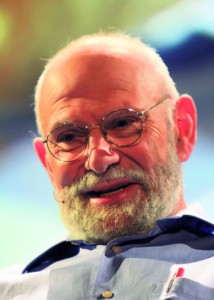WEDNESDAY, 15 MAY 2013
It is rare for a popular science author to find themselves criticised for anything much more interesting than oversimplifying their subject. Dumbing down is not a problem many people have with Oliver Sacks, professional neurologist and bestselling author. His books are popular in the sense of being ‘accessible but enjoyed by everyone’, rather than ‘simple and containing nothing of interest for the expert’. As he opens his clinical casebook in The Man Who Mistook his Wife for a Hat, the reader explores the many curious disorders of the mind both on a personal and technical level. The reader may want to look up some of the more obscure references to the neurological principles each case brings to light, or might fall behind the scintillating analogies Sacks makes between disparate areas of medicine, literature and philosophy. However, they are likely to put the effort in—the subject is too interesting to miss out on.Sacks originally achieved notoriety with the book Awakenings, which describes how people who suffered from sleepy sickness (encephalitic lethargica) were awoken from their decades-long sleep by the new drug L-DOPA. The book investigates how they dealt with restarting their lives after such a break from the world, the lingering effects of the illness and the many adverse effects of the drugs. The tale inspired both a film of the same name and the Harold Pinter play A Kind of Alaska.
However, amongst the acclamation, Sacks has faced significant criticism by several disability activists for his public depictions of the neurologically anomalous. Called “the man who mistook his patients for a literary career” by geneticist and disability activist Tom Shakespeare, he is accused of being nothing more than an intellectual freak show host, presenting each new monstrosity of the mind for our amusement. He is also accused, along with the rest of his profession, of institutionalising the ‘imperialist’ approach to diagnosis: the syndrome is described by the doctor, not the patient.
What is quite remarkable, though, is that many of those he studies barely realise that there is anything abnormal about them: for instance, people with memory problems soon forget them. The man who mistakes his wife for a hat would continue to do so if she did not complain, and our imperialist clinician often has to go to great lengths to demonstrate that he actually has a problem other than bad eyesight (his eyesight is actually fine).
Sacks notes that he only describes case studies after the patients (or, where relevant, the family) have consented, and never with original names. More recently, he has revealed that one case is in fact his own. The Man Who Mistook his Wife for a Hat includes the tale of a man who discovered ‘the dog beneath the skin’, an extraordinarily strong sense of smell that lasted for three weeks after he took a cocktail of drugs. His addiction to amphetamines during his time in San Francisco in the 60’s is not the only source of psychological abnormality. He has suffered from migraines accompanied by visual hallucinations since the age of four and also has the relatively common condition prosopagnosia, or face- blindness. Like other sufferers, he has developed other means of identifying people and these conditions are not generally a problem for him. What he considers his ‘disease’ is his shyness—he has never married and has spent much of his life with few friends. He says he finds it difficult to start conversations: “I never initiate contact. It’s a little bit like some of my Parkinsonian patients, who can’t initiate movement but can respond to music or a thrown ball.”
This interplay of music and psychology is a theme in many of his works but particularly in his book Musicophilia, where he investigates the restorative power of music both on typical individuals and those suffering from severe neurological problems. He is an amateur classical pianist and as a child he described his two favourite things as “smoked salmon and Bach”, so naturally has a general interest in both the clinical and the more spiritual aspects of music. As an art form involving multiple areas of the brain, he finds music more psychologically robust than simply speaking, finding that it brings to life many sufferers of Parkinson’s disease who have largely lost the ability to react to other things. Not that music is universally enjoyed; amusica sufferers are unable to distinguish between music and noise yet live an otherwise normal life, which prevents Sacks from overemphasising music’s importance. Nonetheless, for him “music communicates being alive”.
This idea of music as a form of therapy is also the basis for one of his more recent television series, Musical Minds. The idea is surprisingly controversial. While undoubtedly a fun experience, studies suggest that music has only short-term beneficial effects and although Sacks mentions a few exceptions, people may question what makes it a ‘therapy’ rather than ‘a relaxing or stimulating hobby’. Criticism of the TV series from disabled rights activists is also harder to shake off. The use of physical images of parkinsonian patients listening to music prevents anonymity. Sack’s general style of discussing persons as a whole, of sharing odd quirks and personality traits unrelated to their syndrome, also seems to have been reduced in the television series. It can be understood why this and other television series have not met with the same roaring approval as the books.
As an individual, Sacks has plenty of quirks of his own. He usually eats canned fish for lunch and supper, and as a self-confessed compulsive eater does not keep too much of it in the house. He eats standing up, sometimes reading a book while he does so—the old Oxonian’s love of literature is clear in his works. As with his approach to patients, he has a fairly holistic approach to knowledge, and is as happy exploring the philosophical implications of a woman unable to feel her body as the physical. We normally sense the body directly through proprioception, which allows us to know that our hands are where we put them. This is part of an attack on scepticism championed by G. E. Moore and Wittgenstein, yet here is a woman who doesn’t know where her hands are unless she can see them!
Yet sometimes this holistic approach is to his detriment. A compassionate, individualised response to patients is necessarily opposed to the double- blinded try-it-and-see approach that progress in medicine arises from. While we all want a doctor who does the former, we also want doctors to base their treatments on large, formal studies rather than case studies, and there are times when his erudition spills into the realm of pseudoscience. He refers to Freud in his works more often than to actual scientists and has had twice-weekly sessions with his psychoanalyst for over four decades. However, this does not diminish what he has achieved: a lifetime of bringing to the general public an awareness of the many curious features of the mind, how it can malfunction and how people can continue to function regardless.
Robin Lamboll is a 4th year undergraduate at the Department of Physics


